The need for waterproofing basements. Types of insulating materials, their characteristics and advantages. Work technologies for each of the waterproofers.
Why do you need basement waterproofing
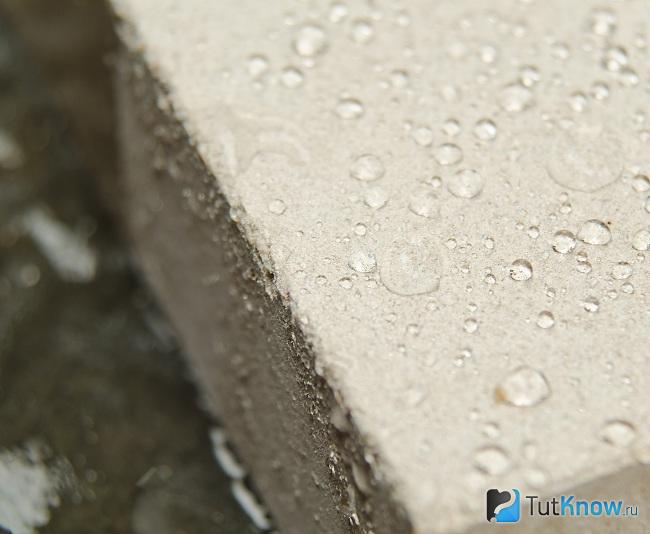
Protecting the room from moisture penetration is a task that must be solved when laying the foundation. During the construction of the facility, a number of measures are carried out that create obstacles to the ingress of water into the walls and floor of the basement. The highest quality waterproofing is achieved only at the time of construction. Measures taken in an already constructed room may not give the calculated result. The following types of basement waterproofing are used: anti-pressure, non-pressure, anti-capillary.
Anti-pressure waterproofing is carried out in cases where water rises beyond the floor mark, and often reaches the walls of the basement. Then the work is carried out outside the building. Waterproofing inside the basement is not effective, as the water there tends to pull the material away from the wall. In addition to these measures to prevent moisture from entering the basement, it is necessary to make a drainage system around it and drain the existing water into the storm system.
Non-pressure waterproofing is done when the level groundwater not high and the possibility of flooding is zero. Protect surfaces only from slight penetration of atmospheric precipitation into the soil. Here it is more advisable to cover the entire basement with bituminous mastic.
Anti-capillary waterproofing is carried out in order to protect the basement walls from water penetration through capillaries. Previously, bituminous mastic was used for this or covered with sheets of roofing material. Now they use penetrating waterproofing agents.
The choice of materials for waterproofing the basement
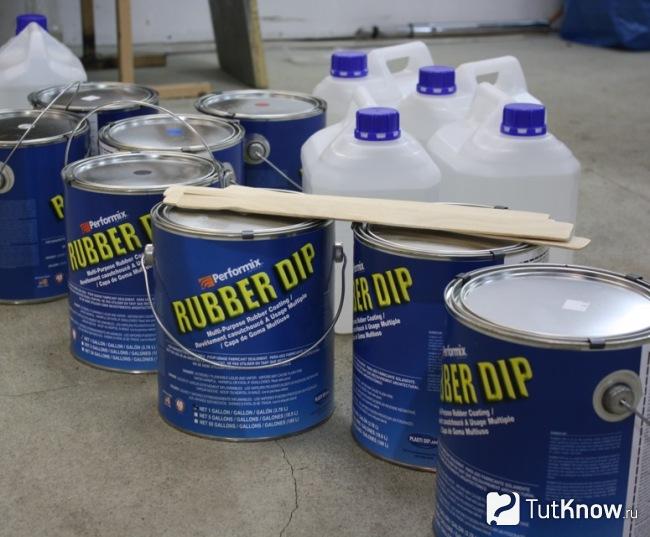
Waterproofers that are offered to the consumer are usually classified into the following groups:
- Coating... These means include mixtures based on bitumen, they are used cold and with the help of heating. This group also includes cement compounds, polymer-based mixtures, thick-walled bituminous coatings. The base of the solution is bituminous resin with the addition of synthetic rubber. It contains no solvents. It is used on different types surfaces: brick, concrete, stone, plastered. Cement waterproofing is a composition of polymers with the addition of cement. This insulator is vapor-permeable and has high adhesion, therefore it is often used for internal waterproofing works. Considering that it contains polymers, it is flexible in use, its application does not require special knowledge, and its advantage is its affordable price. The main disadvantage of do-it-yourself cement-based waterproofing basement is the fragility of the material.
- Liquid rubber... It contains bitumen and various polymers. Its key property is the ability to firmly bond the insulator with the molecules of the treated surface. Liquid rubber is a material that has many positive properties, such as durability, inability to be exposed to microorganisms, temperature extremes, and ultraviolet rays. It is resistant to water pressure, has good adhesion, fire safety, low price and high maintainability.
- Liquid glass... It has the same properties as rubber: hardening, it protects the treated surface from moisture. The main components of the material: sodium silicate with the addition of sand and soda. Available in liquid or dry form, diluted with water and used for basement waterproofing. Differs in high adhesive qualities, corrosion resistance, no need for application special equipment... The disadvantages of the insulator include the inability to use on any type of surfaces.
- Roll... The industry offers a large selection of roll insulators, which include bitumen and polymers. The main materials of this group are roofing felt and roofing felt; glass roofing material, brizol, hydroizol, foilgoizol are also on sale. The basis for roll insulators is mastic, which is put in a heated form or used in a cold way, or the material is fixed by melting. Among the positive qualities of roll insulation, we highlight the relatively inexpensive cost of work and the ability to perform gluing on our own. The negative aspects that arise when waterproofing a basement is a loss of quality at low temperatures, the ability to be exposed to microorganisms and mechanical damage.
- Penetrating... The point is the reciprocal reaction of the material and the processed plane. The waterproofing agent applied to the surface is absorbed through the capillaries to a depth of 0.4 mm and crystallizes. This process is possible only due to the action of penetrates - special components that are part of the insulator. Therefore, materials for penetrating waterproofing are called Penetron. Silica or aluminum oxide is added to the composition of the substance to impart penetrating properties. The use of Penetron as an insulator is associated with its penetration into the pores of concrete, while waterproof crystals are formed. The mixtures used as penetrating insulation have the following positive qualities: the ability to penetrate to a depth of more than 0.5 mm, which makes it possible to improve the waterproofing of concrete, close any microcracks, and are characterized by a long service life. The treated surfaces are resistant to low temperatures, and the material is easy to use.
- Injection... This waterproofing has excellent penetrating properties. The flowable gel is injected into the holes prepared in advance for this purpose. The product can be used even in damp rooms, and the surfaces are not subject to special preparation. Injections allow you to penetrate into any hard-to-reach places, plus a small investment is required.
Note! Working with injection isolation wards requires certain practical skills and training, unlike other materials.
Basement waterproofing technology
The sequence of work is different depending on what kind of material for waterproofing the basement is chosen.
Application of coating waterproofing
Waterproofing materials include cement coating, rubber mastic, liquid rubber and water glass. Consider the application technology for each insulator.
Cement coating
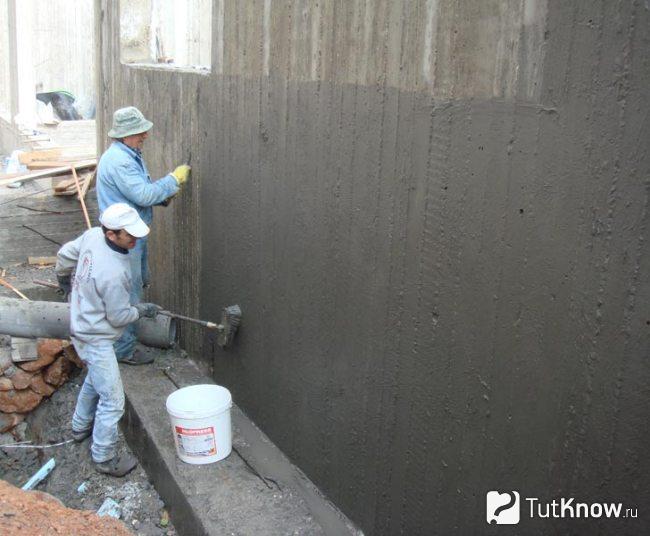
Before starting to apply the cement waterproofing coating, the following tools must be prepared: a working bucket, a brush, a roller or a spatula (it all depends on the consistency of the solution). Materials that will be needed for work: flexible cement paste, water.
The instructions for carrying out the work will be reduced to the following actions:
- All treated surfaces are cleaned of old cement, all kinds of irregularities.
- Regardless of the material (mastic or cement coating), the area is abundantly wetted with water. The insulator adheres better to a damp surface and goes deeper into the pores.
- When applying a cement coating, the dry mixture is diluted with water. The solution must be well moistened, otherwise it will not adhere well to the surface.
- The mixture is applied with a brush, roller or spatula, it depends on the consistency.
- After the surface has dried, it is finished.
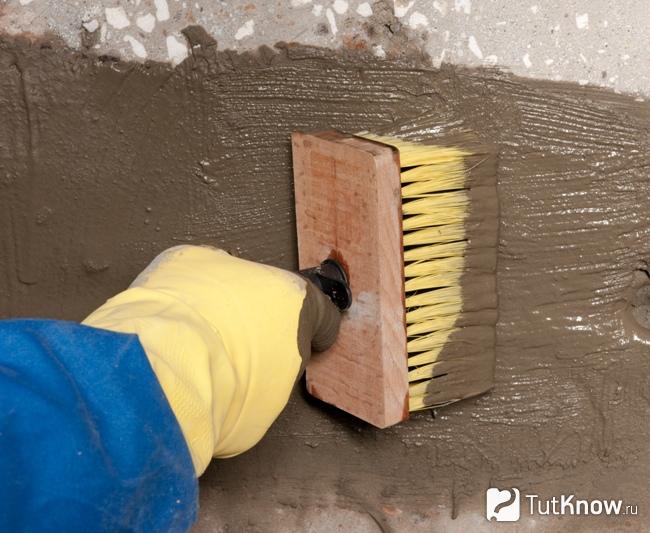
The use of mastic implies its application outside the building in order to protect it from water ingress. Before applying it, you must prepare the following tools: a brush or roller (depending on the consistency of the mastic), a spatula, a working bucket.
The algorithm for carrying out work with rubber mastic is as follows:
- The surface to be treated must be cleaned of old cement, dirt and debris.
- The surface is well moistened with water, this enables the material to better penetrate the concrete structure.
- The mastic is mixed and applied to the walls.
- When the surface is dry, you can plaster it.
Liquid rubber
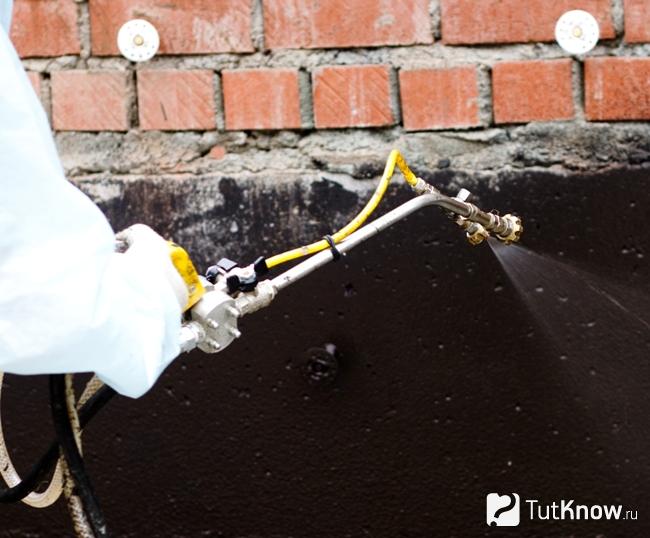
To work with it, you will need the following tools: a roller or special installation... Materials used for applying liquid rubber: antiseptic primer, insulator, special fabric.
The technology boils down to the following works:
- Basement walls are cleaned of dust, dirt and existing fungi. If there are irregularities on the surface, they must be putty, as an excess amount of material will be used.
- A primer is applied to the basement wall, which performs an antiseptic function and promotes better bonding of the material and the base. It is thrown at all corners and crevices, then they are covered with a special cloth, this makes it possible to better seal the seams. After that, the entire wall is already primed, as a result, the seams and corners are primed twice. The solution dries out for 3-4 hours, it depends on the ambient temperature and the presence of ventilation in the basement.
- Liquid rubber is applied to the walls with a roller or a special machine that evenly distributes the insulator over the wall surface.
- After curing, a film forms on the base that protects it from moisture. Now you can carry out finishing work.
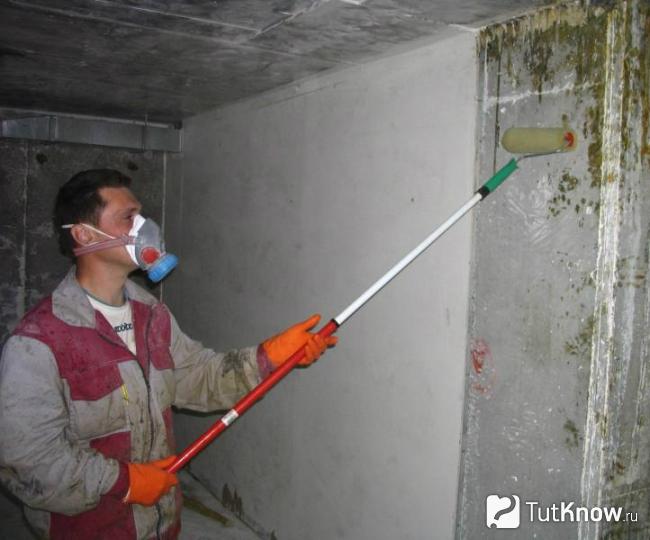
To work with it, we need the following tools: a brush or roller, a working bucket, a spatula. Materials to be used: liquid glass, water, plaster.
The technology for using liquid glass inside the basement will be as follows:
- We clean surfaces from dirt. Large irregularities can be removed with a chisel or chisel. After that, large debris and dust are swept from the base.
- Before using the insulator, we first wash and then degrease the walls.
- We apply liquid glass first to all corners, crevices, then cover the entire area to be treated.
Installation of roll waterproofing
![]()
Tools that are required for stacking such materials: brush, roller, working bucket, sharp scissors. Necessary materials: roll insulator, e.g. roofing material, primer, bitumen mastic.
The technology for using roll insulators is as follows:
- The walls are cleaned of everything unnecessary: \u200b\u200bdirt, debris, concrete adhesion. It is advisable to wash the surface and let it dry thoroughly.
- Then the walls are covered with an even layer of soil mortar, which dries up within a few hours. It is leveled with a roller evenly over the entire area.
- When the surface dries, bituminous mastic is applied to it. During the drying process, it forms a stable, uniform coating.
- The final stage: the roofing material is cut into strips, laid on top of the mastic with an overlap of 15 cm. This is done to isolate all the joints of the wall.
Application of penetrating waterproofing
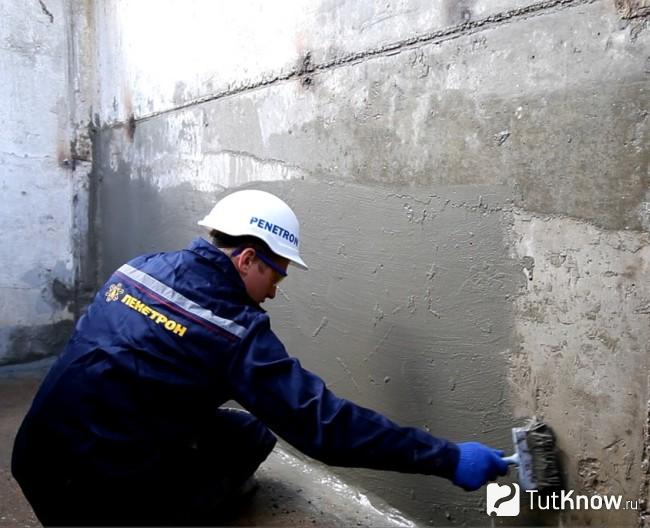
Tools used in the work: wide roller or brush, bucket, metal brush. Materials for work: Penetron dry insulating mixture, water.
The application technology boils down to the following algorithm of actions:
- The surface to be treated is prepared, cleaned with a metal brush.
- Then it is abundantly moistened with water, this is necessary so that the pores of the concrete open well, and the insulating mixture gets as deep as possible.
- Next, a solution is prepared: the dry insulating mixture is combined with water.
- First, all corners, joints are processed, then the rest of the surface is covered. The walls are treated with mortar several times. Moreover, at least 2 hours should pass between the application of the first and each subsequent layer.
- The treated surface must be watered with water for several days, this is done in order to uniformly harden the material.
Application of injection waterproofing

Tools used in the work: injection pump, packers, perforator. Materials for work: mixture for waterproofing.
The algorithm for performing injection isolation will be as follows:
- Holes are prepared using a hammer drill equipped with a heavy-duty drill. A lot of holes need to be made - they are drilled at a distance of 1-2 cm from one another.
- A special device "Packer" is inserted into the hole, through which the prepared mixture is pumped under pressure using an injection pump.
- The insulating mixture should dry within 10-12 hours. It is desirable to be able to ventilate the room. After drying, the room can be used as usual.
It is not difficult to waterproof the basement from the inside if you stock up on the necessary tools, materials and carefully follow our instructions. Thanks to them, in a few days it will be possible to dry the room and protect its surfaces from the appearance of microorganisms.
The foundation and basement of the house are the most vulnerable areas on which the hydraulic pressure of groundwater and atmospheric precipitation is exerted. The additional load can be reduced by installing a strong moisture-resistant insulation layer. Excess liquid collects in the walls, leading to the appearance of fungus and smoldering finishing materials and load-bearing structures... How to make basement waterproofing so that such problems do not arise?
It is very important to consider the groundwater level at the place of construction of the house.

Groundwater location
The waterproofing barrier is equipped in the following cases:
- Groundwater is located above 1 meter from the level of the foundation to be laid. This is high, therefore it is necessary to ensure a high-quality external and internal watertightness of the basement.
Advice!
In cases of a high location of groundwater, experts recommend additionally equipping the drainage system. This will prevent the building from hydrostatic pressure, which can cause the foundation of the house to shift and deform the walls.
- Groundwater is below 1 meter from the base. In this case, simple waterproofing of the walls is suitable.
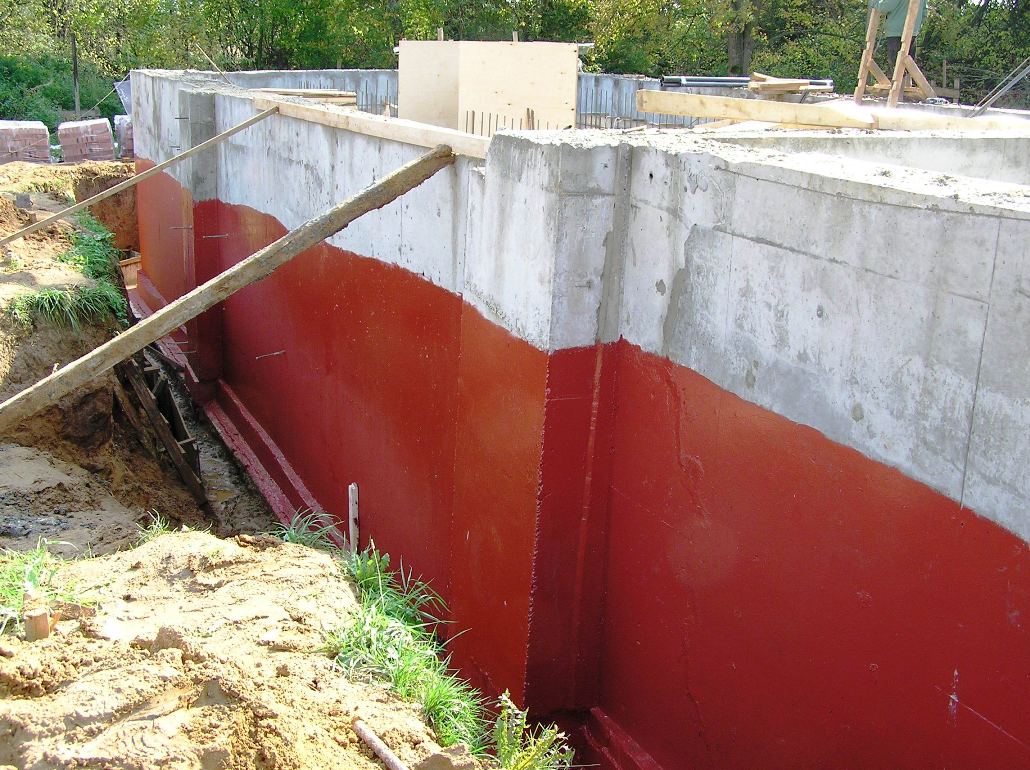
External waterproofing of the basement at the stage of foundation construction
External waterproofing is not possible in already built and tiled houses. Therefore, work must be done from the inside. In this case, the effectiveness of waterproofing will decrease significantly. To increase the water-repellent properties, it is recommended to carry out a comprehensive waterproofing of the building against the absorption of excess liquid by treating the walls and floor of the basement.

Types of basement waterproofing
The internal waterproofing agent is selected according to the selected application method. There are 3 types of waterproofing: anti-pressure, non-pressure and anti-capillary.

Types of basement waterproofing
- Anti-pressure waterproofing is performed when the groundwater level is above the level of the basement or basement floor. The foundation is waterproofed outside the building. The materials used restrain the positive water pressure. Additionally, a drainage system of the site is being performed to drain the liquid into the drain. Means for performing anti-pressure, or slurry, waterproofing necessarily contain polymers. A bitumen-polymer composition is applied to a surface pre-treated with a silicate primer. Slurry waterproofing is a multi-layer surface consisting of different solutions and mastics.
Important!
Performing anti-pressure waterproofing from the inside is a useless exercise. Since water exerts negative pressure on the walls of the house, and is not held back by narrowly targeted insulating materials.
- Non-pressure waterproofing is performed when urgent protection of the basement from already accumulated moisture is needed. If the groundwater is low, it is quite possible to cope only with non-pressure waterproofing of the walls and base. In this case, bituminous mastics are selected, which are applied with a spatula or roller to the surface of the walls.
- Anti-capillary waterproofing is used to prevent moisture from entering through the capillaries located in concrete wallsoh. Previously, only bituminous barrier mastics and roofing felt were used protective layer on the foundation. Currently, the most popular are penetrating waterproof materials. Condensation does not collect on the walls of the basement if they are pre-treated with barrier mixture injections. They penetrate the voids and fill them, blocking the flow of water.
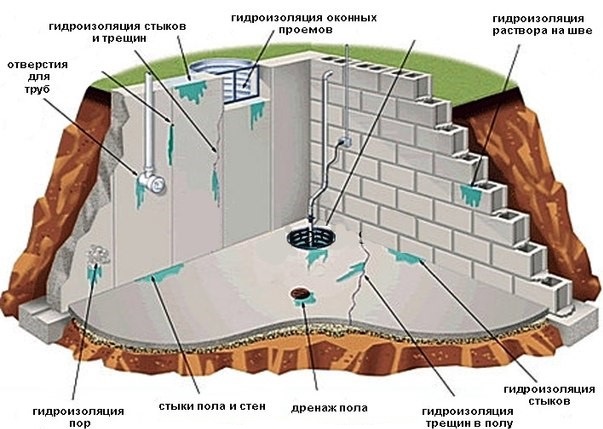
Sources of moisture in the basement
The highest quality is the outer protection of the basement from groundwater. Quite often, external waterproofing is missing or damaged. It is sometimes impossible to repair it. Therefore, there is an urgent need for the arrangement of internal insulation. In such cases, the basement is waterproofed from the inside with your own hands without the use of special equipment and earthworks.

Basement waterproofing is a guarantee of warmth and comfort in the house
Penetrating compounds and membrane waterproofing sheets are currently used. Membrane slabs are laid on the walls using a gas burner, forming a dense, water-repellent layer.
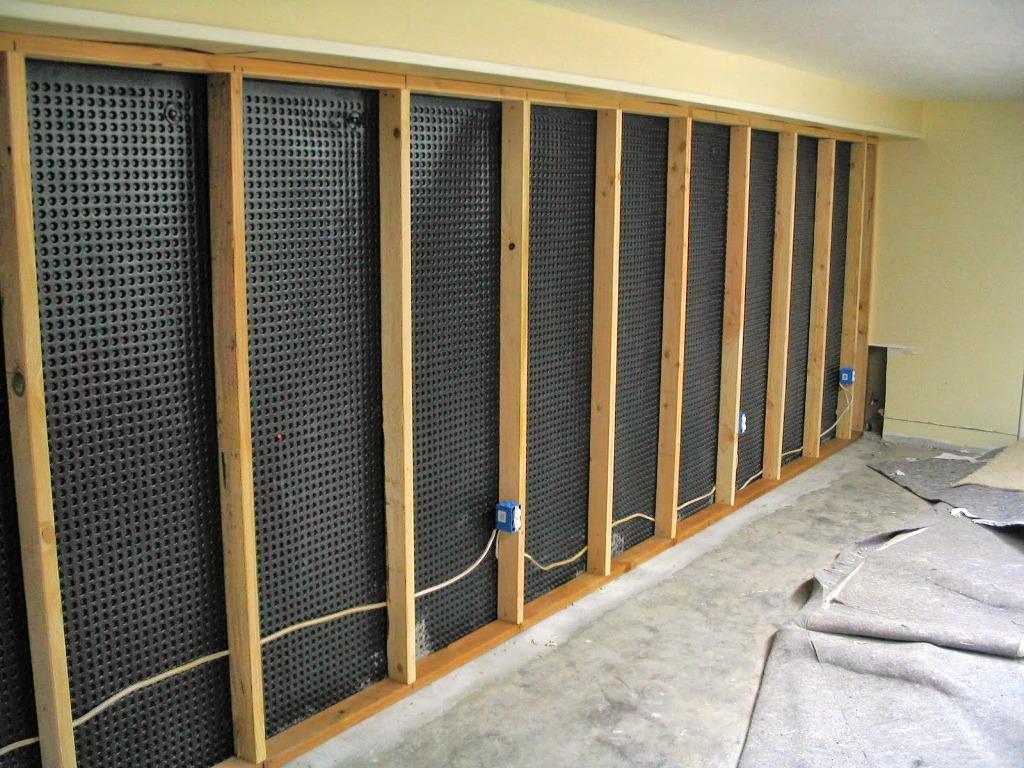
Basement membrane waterproofing
Penetrating coatings form insoluble, water-repellent barrier compounds by chemically reacting with concrete. Thus, the composition penetrates into the capillaries and fills the pores, chips and microcracks in the concrete.
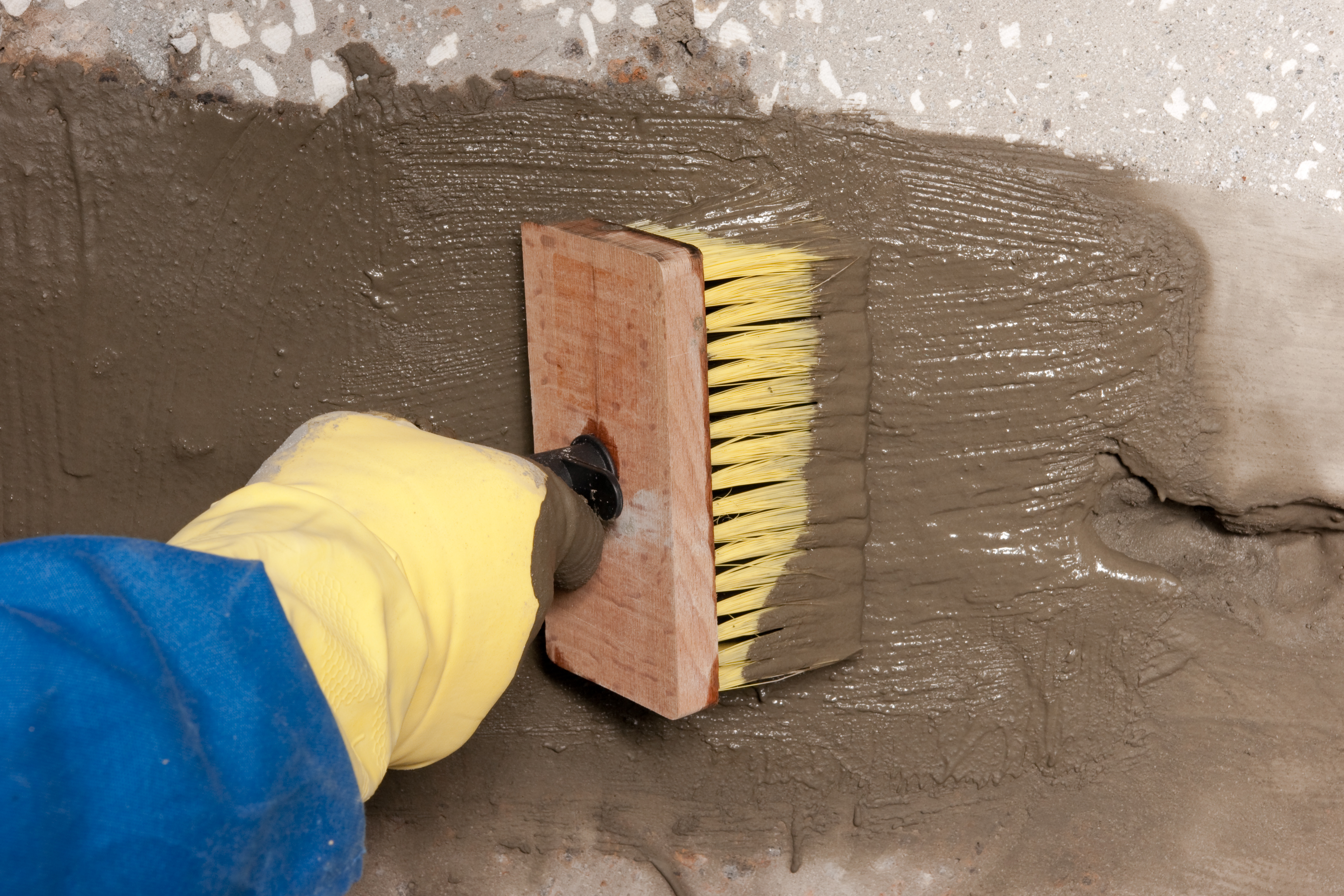
Anti-capillary basement waterproofing with bitumen mastics
How to properly waterproof a basement with bituminous mixtures? Internal water repellents for the basement are polymeric mastics. The high demand for such water-repellent products is due to their low price and good properties.
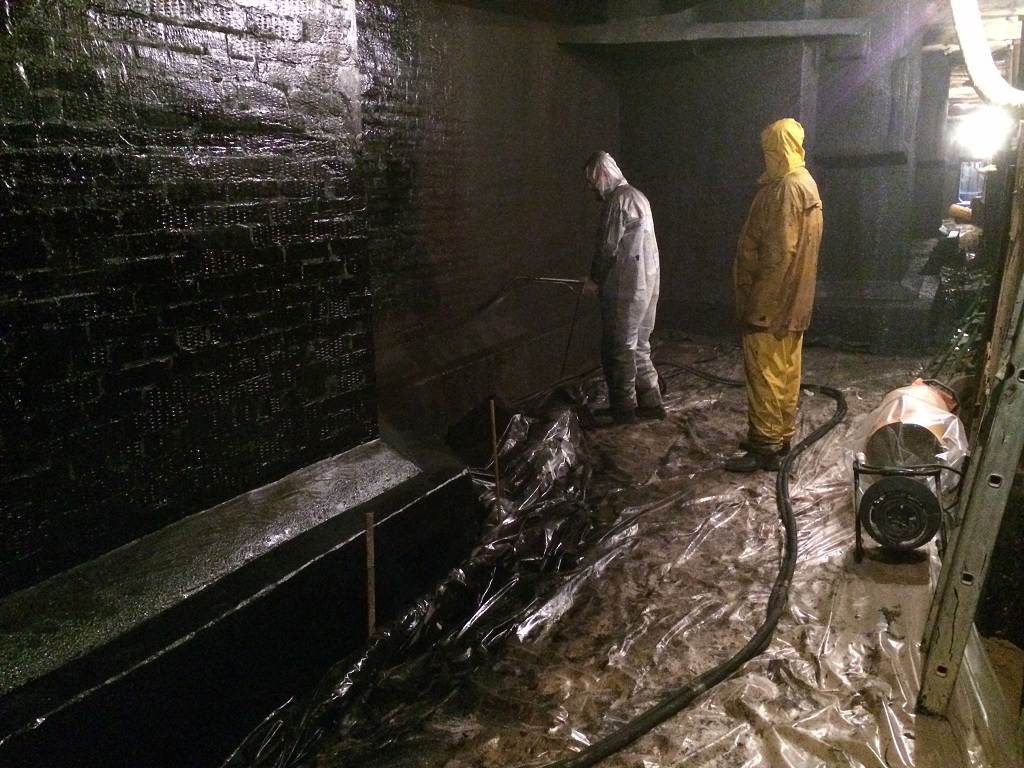
Basement anti-capillary waterproofing with bitumen mastic
Work on the application of bitumen mastic is carried out in the following sequence:
- walls are wiped, if necessary, all debris and residues are removed old finish;
- with fine-grained cement mortar, trim the surfaces of the walls, wipe cracks and potholes;
- prime the surface with a quick-drying primer;
- Apply a waterproofing layer of mastic evenly with a spatula.

Waterproofing with bitumen-based mastic
Adhesive insulation
The glued waterproofing forms a monolithic canvas, which consists of several layers of rolled materials.
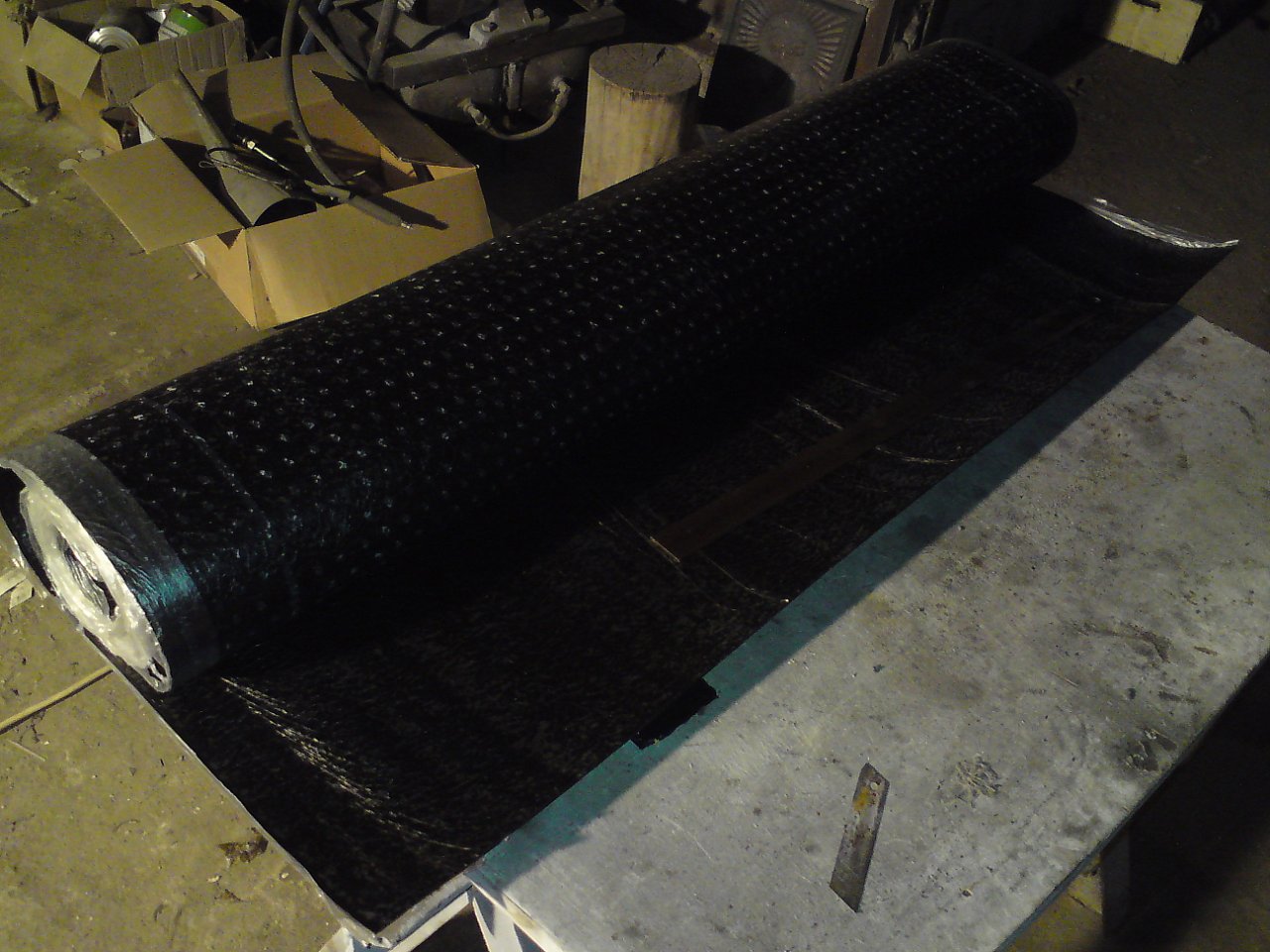
Roll waterproofing
Roll coatings are glued by heating the base with gas burners or on bitumen glue. The scheme of work is as follows:
- mastic is applied to the basement wall;
- then a roll insulator is glued to the mastic layer, rolling with a roller;
- the overlap places are treated with mastic and the next layer of the roll cloth is glued;
- rolled waterproofing sheets are rolled with a roller. They can be glued both vertically and horizontally. The excess material at the edges is cut off with a sharp knife.

Roll basement waterproofing at the initial stage of construction
Wall plastering is performed on any uneven wall surfaces with potholes and cracks.

Plaster waterproofing
The scheme of the work performed is as follows:
- Clean the surface to be treated from debris and old cladding with a wire brush or spatula.
- Apply a coat of primer for best adhesion of materials.
- Install level beacons.
- Throw ready-made waterproofing plaster into the spaces between the lighthouses, having previously prepared it in accordance with the instructions on the package.
- Level the surface with the rules, focusing on the beacons.
- Remove the beacons after the plaster has set and fill the resulting joints with mortar, level the surface with a spatula.
- Finish dry plaster with a finishing layer of mortar.
Waterproofing plasters contain modifiers, plasticizers, binding adhesion additives and components. Can be used for outdoor and indoor use.
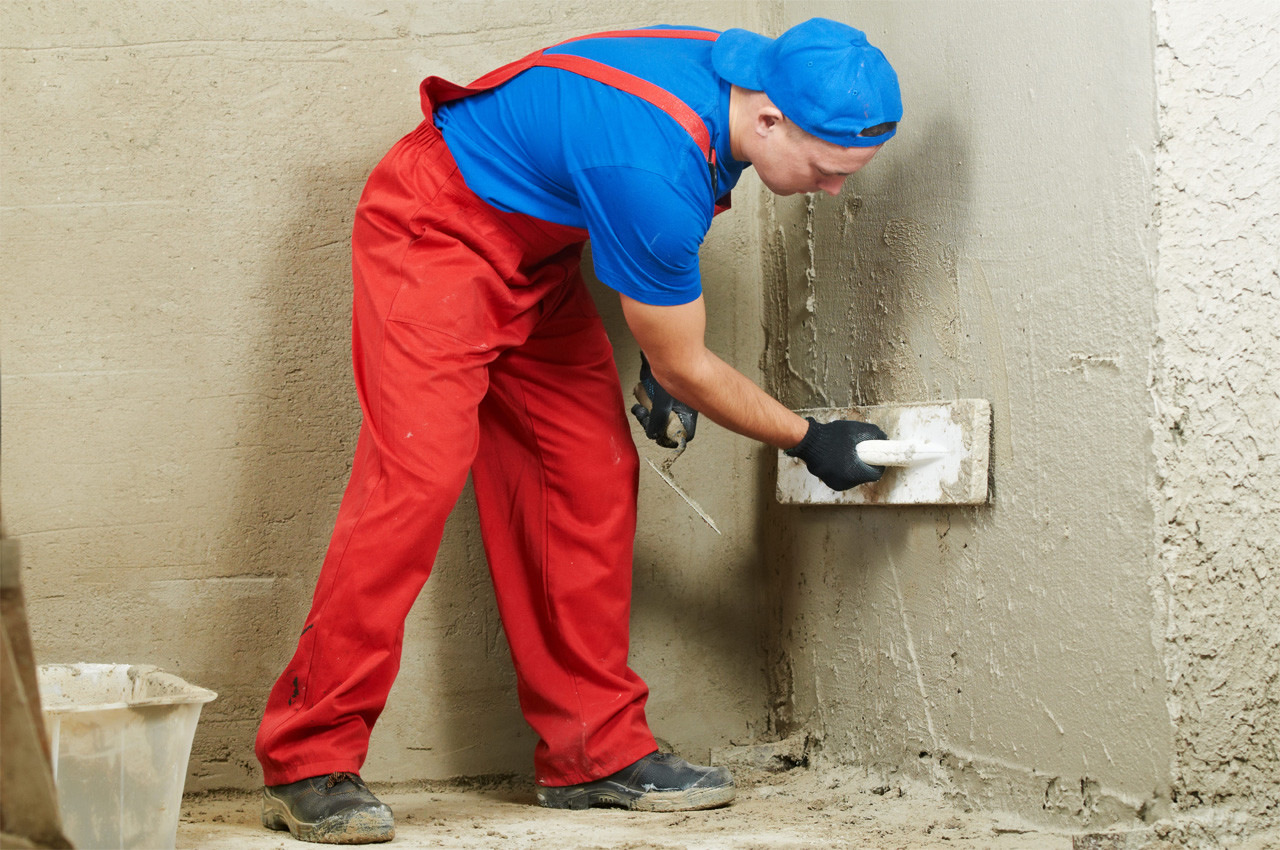
Waterproofing with plaster
Basement penetrating waterproofing
Penetrating water-repellent compounds can be divided into types:
- mixtures applied from inside and outside the building to concrete surfaces;
- compounds for sealing joints, chips, seams, cracked surfaces;
- quick-hardening compounds that stop leaks in a few minutes;
- compositions for adding to concrete solution.

Basement waterproofing penetrating action
The difficulty of using penetrating mixtures is that special techniques or laborious manual cleaning are required to clean concrete walls.
Important!
The composition penetrates into the concrete capillaries only if they are open. If the capillaries are clogged, the penetrating moisture-repellent compound will not penetrate the concrete, and the work will be done in vain.
Basement waterproofing works using penetrating compounds are carried out only on freshly poured or damp concrete. The mixture is applied with a spatula or brush in one to two millimeters. After the first layer has dried, a second one is applied.
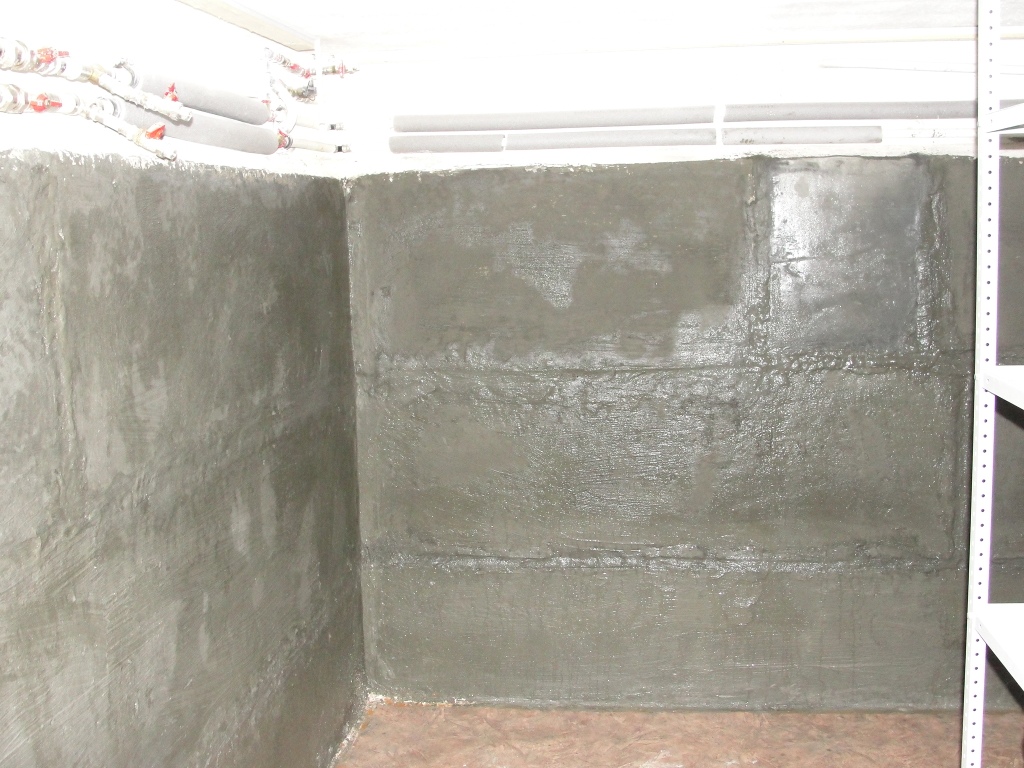
Penetrating basement wall waterproofing
Liquid rubber waterproofing scheme
Liquid rubber is the newest bitumen-polymer water-repellent material. It can be used to further increase waterproofing properties walls and floor in the basement. One-component formulations can be easily applied independently with a roller or brush on a flat surface.
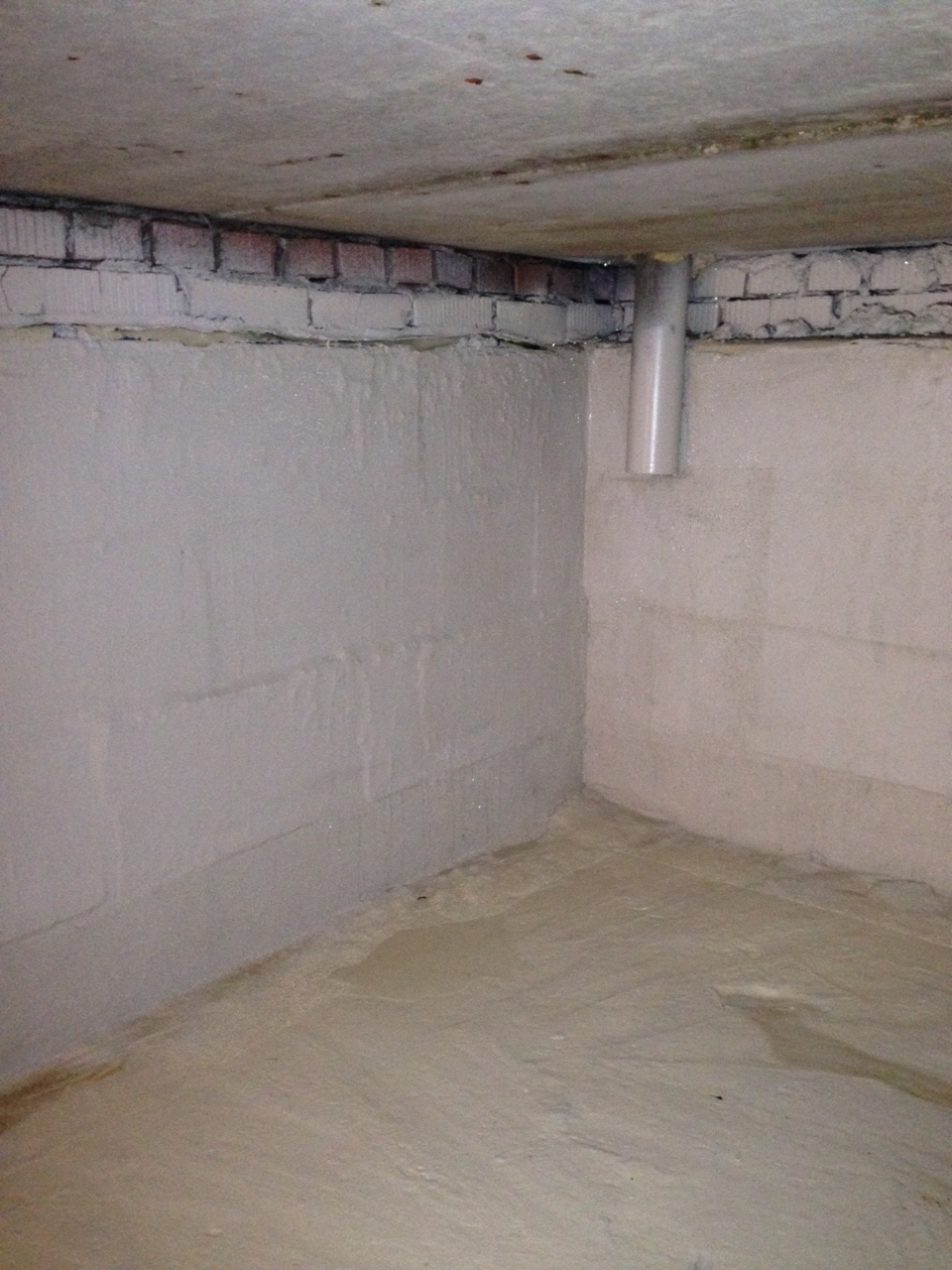
Basement waterproofing liquid rubber
The order of work:
- Before applying the mixture, it is necessary to thoroughly clean the surfaces to be treated and fill in the potholes and irregularities.
- Treat walls and floors with a primer.
- Thoroughly mix the liquid rubber composition using a drill and a mixing nozzle.
- Apply the mixture with a brush, roller or spatula.
- After complete hardening, the coating is ready for use.
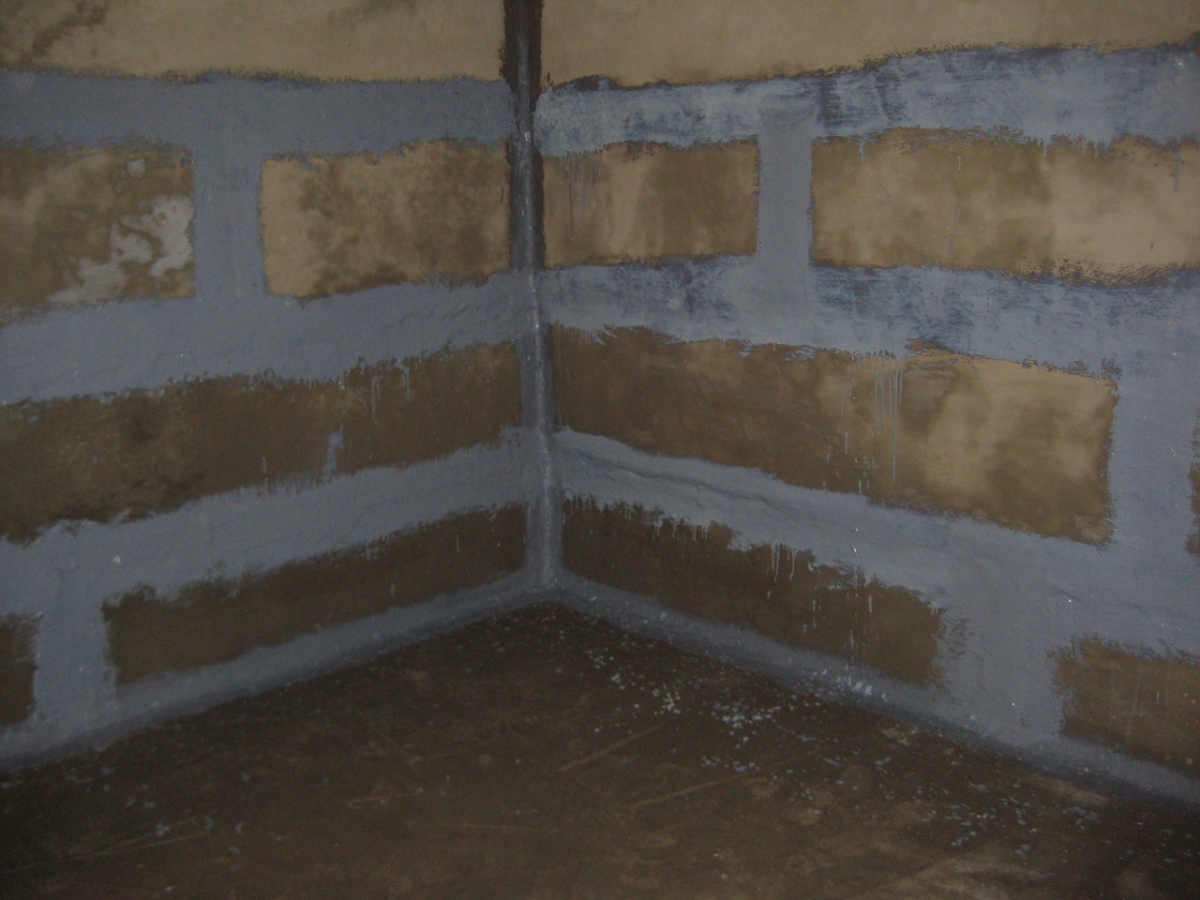
Waterproofing joints liquid rubber
Despite the assurances of the liquid rubber manufacturers that the composition penetrates 15 millimeters deep into the concrete, under the strong pressure of high groundwater, the coating begins to peel off and ultimately can last no more than 5 years. An additional floor screed will extend the life of the rubber water-repellent compound.

Basement waterproofing with liquid rubber
There are several methods for waterproofing a floor:
- painting;
- pasting;
- impregnating;
- cast.
The painting method is used for pouring concrete floor covering. This is the simplest type of moisture protection. Paint waterproofing is carried out with barrier polymer-bitumen compounds. This polymer is short-lived and loses its elastic properties over time, forming cracks. In our time, preference is given to bitumen-rubber mastics, which do not lose their elasticity for a long time.
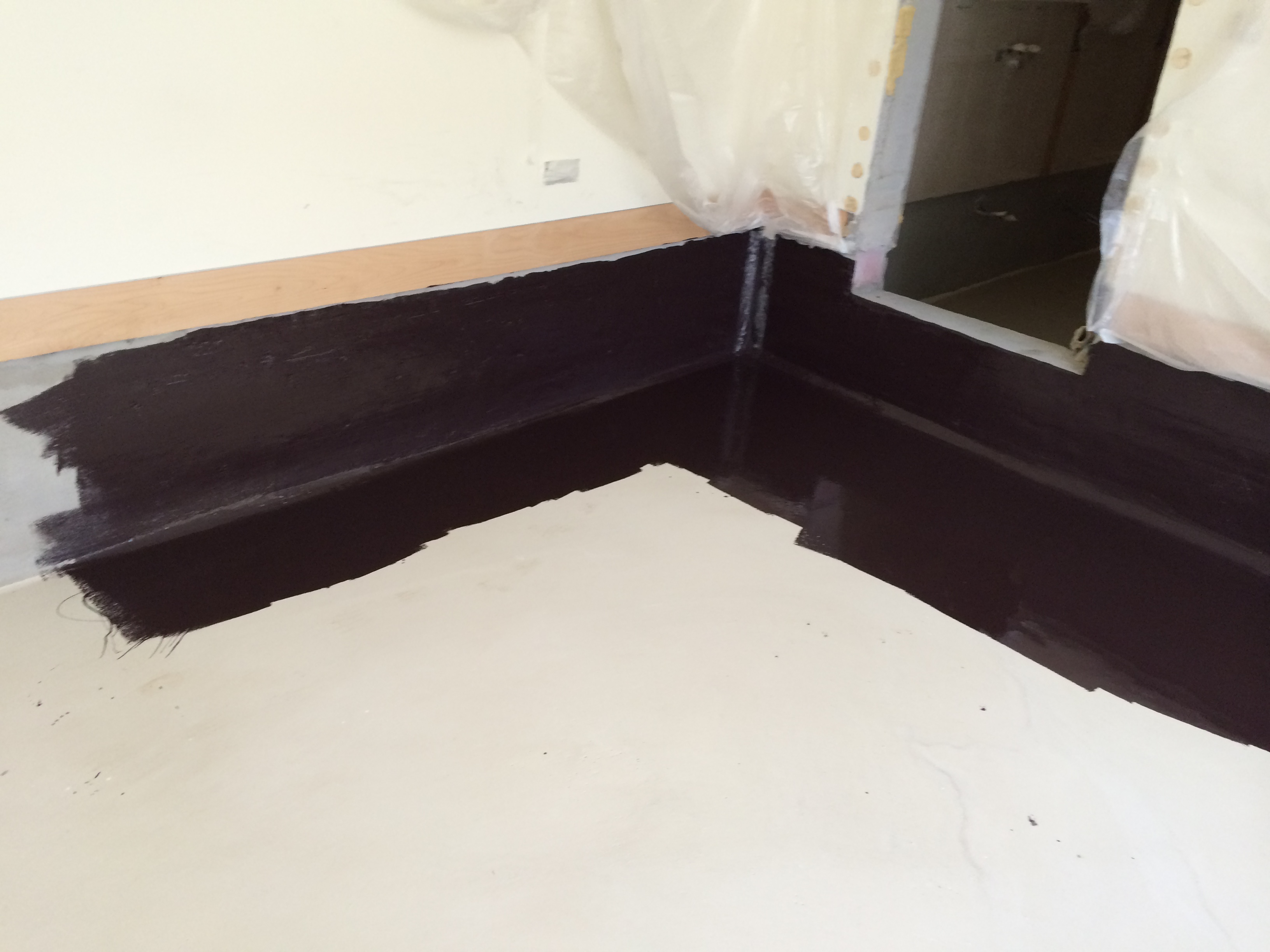
Floor paint waterproofing
The gluing method of waterproofing is applied during the floor filling. At the stage of the final concrete screed, layers of sheet or barrier roll materials are laid. Each layer is glued with a bitumen-polymer primer, depending on the selected material. Thus, a dense, reliable and moisture-resistant polymer coating is obtained. It is enough to lay three layers of coating.
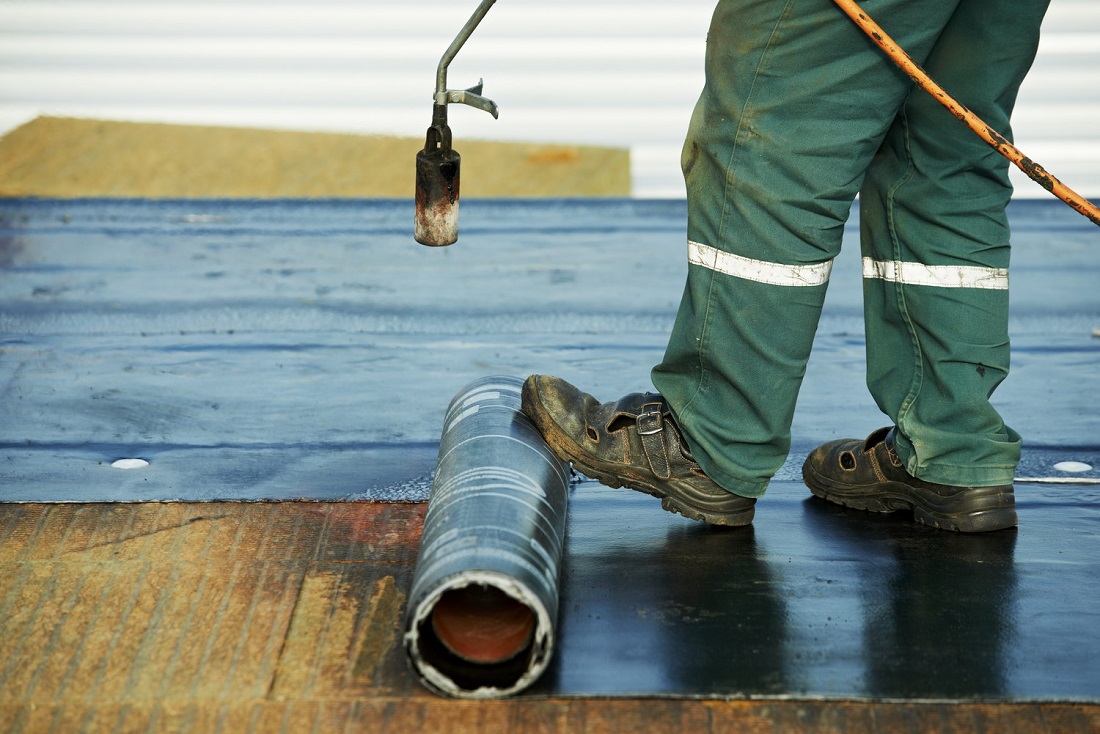
The glued method of waterproofing the floor
The impregnating method of waterproofing is used before the floor is tiled with wood, linoleum or tiles. The composition of the impregnating mixtures necessarily includes polymer substances, such as varnish.

Impregnation method of waterproofing the floor
The cast method of waterproofing the basement floor is by far the most reliable. A fence is installed between the walls and the basement floor. A polymer solution is poured into the resulting space, after drying, a dense continuous cast bitumen-polymer moisture-repellent coating is formed.

Cast waterproofing
Waterproofing is divided into types in accordance with the temperature operating conditions:
- cold;
- hot;
- asphalt-polymer.
Important!
Any process of arranging a waterproofing layer must be carried out continuously. Places of joints, overlaps and abutments of the coating roll cloth must be carefully processed additional layer bituminous or barrier polymer mastic.
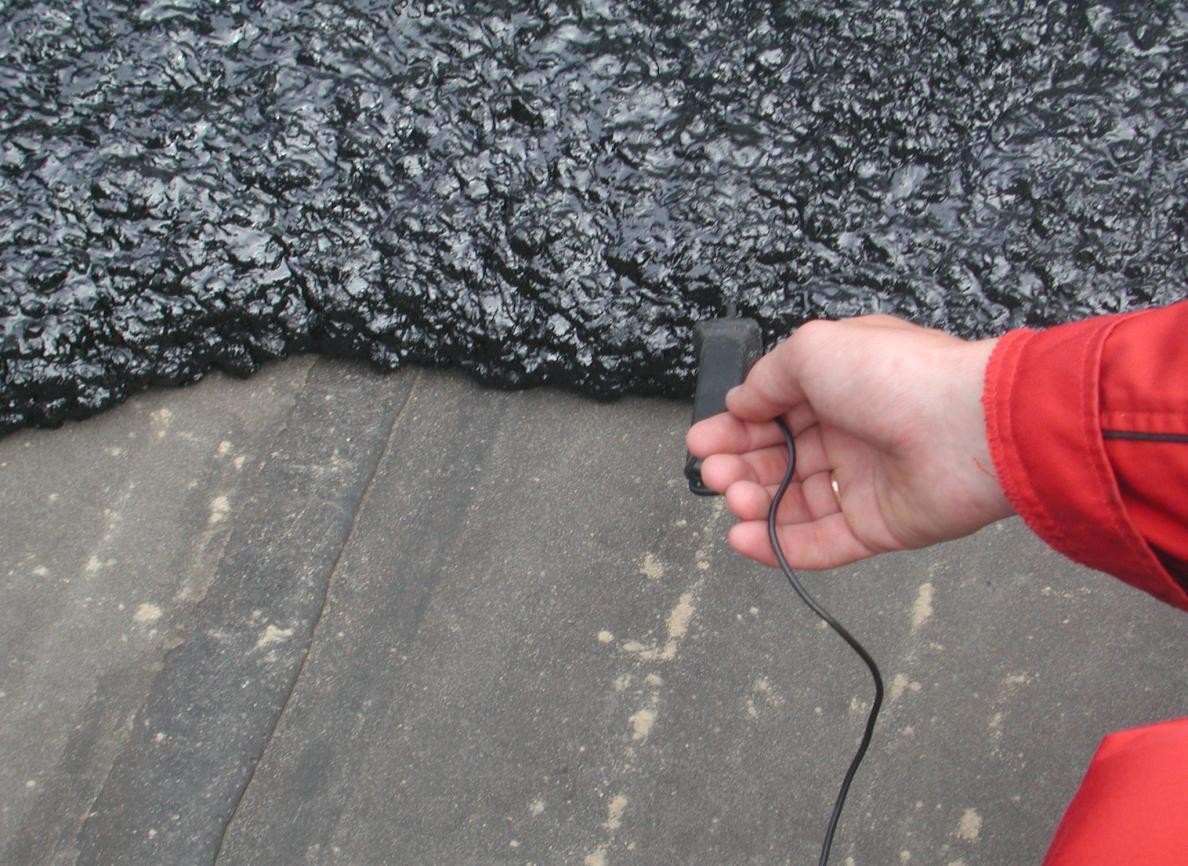
Asphalt-polymer waterproofing
Basement waterproofing will be more effective if the basement ventilation system is installed. It is possible to enhance the work of the equipped ventilation with the help of a forced supply duct.
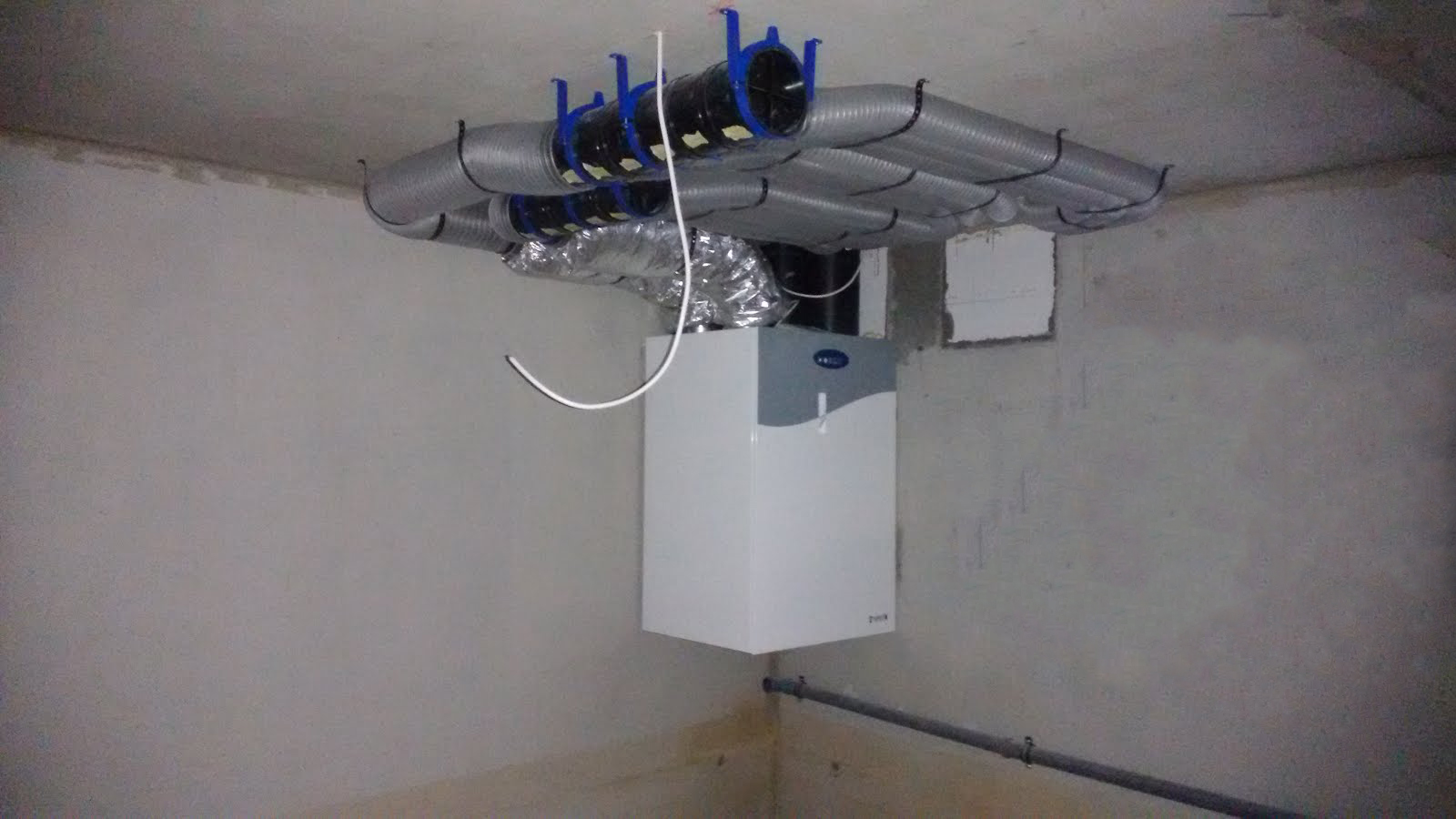
Automatic ventilation of the basement
A properly equipped waterproofing system will extend the life of not only the basement, but also the entire house, prevent dampness, the occurrence of fungi, mold and decay of materials.
Basement protection from groundwater and sediment accumulation should be provided even at the construction stage. But re-waterproofing may also be required due to its destruction during the operation of the building.
Reasons for the appearance of excessive dampness in the basement
A large accumulation of water and its condensation in the basement can occur for the following reasons:• deformation of the foundation in old buildings and the presence of cracks in the floors and joints, through which water seeps;
• absence of blind area or its destruction and, as a consequence, wastewater leakage under the foundation;
• raising groundwater.
Dampness in the basement
In all of the above cases, waterproofing only inside the basement will be a waste of money... Moreover, when the repair of the foundation and blind area is delayed, a violation of the integrity of the building may occur. Basement waterproofing from the inside is carried out in this case only as additional measure protection against moisture.
If the groundwater is close to the surface
Trying to pump (drain) groundwater from the basement is not a very smart decision. Groundwater is a kind of river that extends far beyond the house. Fortunately, in most cases it is located deep underground. If it comes close to the surface, you shouldn't even try to scoop it out.
The first couple of years, the basement will not fill up with water very quickly. But after her regular pumping out the duct (canals connected to underground water) in your basement clean up, and water will have to be pumped out not only during floods, but all year round... Moreover, too radical drainage measures can cost the foundation, and, as a result, the whole house.
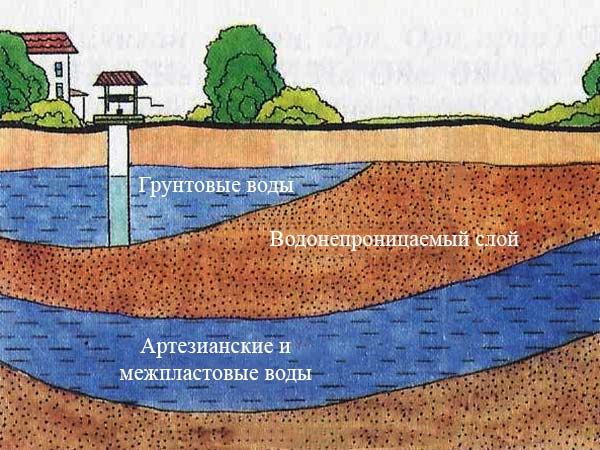
Groundwater location
Perhaps the only solution to the problem of flooding the cellar in this case is raising the basement floor to a considerable height.
Cellar drainage
Basement waterproofing should only be done in summer after a flood and a decrease in groundwater activity... All ventilation systems must be fully open to remove condensation. In difficult cases, you can use a heat gun.Important! Excess water can be scooped out, but not pumped out, so as not to wash out the channels and not increase its flow!
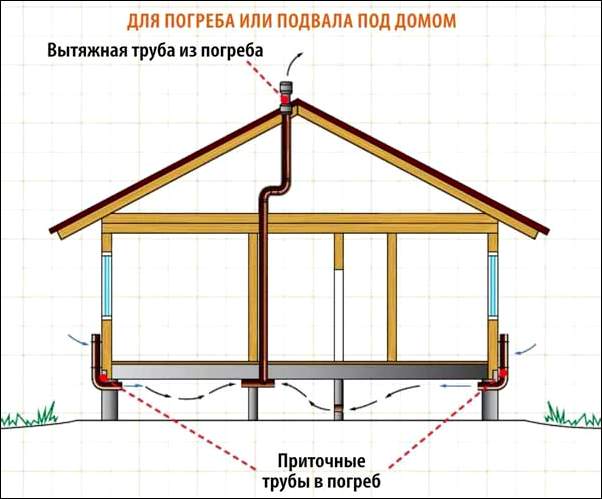
Scheme of ventilation openings in a cellar or basement
Raising and waterproofing the basement floor
It is very difficult to cope with groundwater. But, if the foundation is dry, it is possible that the basement has only a spring is trying to break through somewhere... In this case, raising the basement or subfloor to a significant height will help to cope with the problem. This will also help if the groundwater did not rise too high.A wonderful old old-fashioned way is the structure for protection from groundwater of the so-called "Clay castle"... It is envisaged even at the construction stage and is laid on the foundation. In our case, before filling and pouring the floor, it will be laid in a layer of 40 cm only in the cellar.
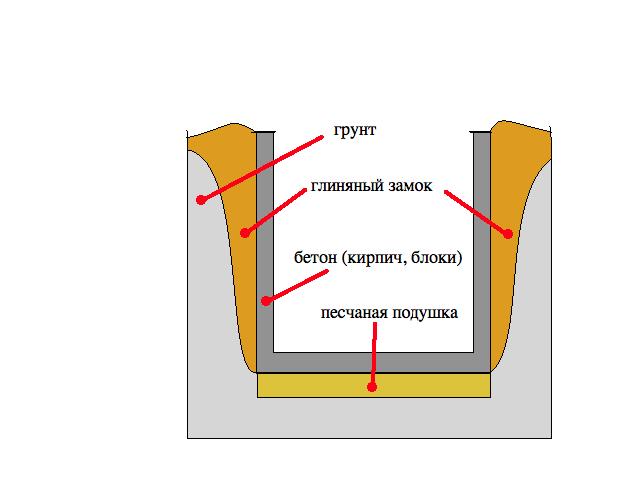
"Clay castle"
1. For the construction of a "clay castle", the earth in the cellar or subfield is selected before dampness appears and is replaced with clay. You should use only the fattest, which will not let water through. It is advisable to take dry clay or slightly dampened so that it collects the remaining moisture from the floor while stirring. Such a "lock" is laid in small layers, while each layer is carefully rammed (in the old days, clay was kneaded with feet). By the walls it should be hammered as tightly as possible.
2. Then fit and sand is compacted, and it is better to use a denser screening.
3. Falls asleep on it rubble layer.

Pouring concrete
4. Before the screed layer is laid waterproofing (roofing material, polymer film, isoplast, etc.).
5. The last layer will be reinforced concrete layer 5 cm, which will give the necessary load. To reduce the water pressure on its surface from below, the screed can be supported on the walls. To do this, holes are hollowed into them, into which they are inserted steel beams.
6. To insure against swelling of the floor, you can make it heavier by laying a double layer of concrete. To do this, the first layer, kept for drying for 2 weeks, is covered with mastic and roofing material, and then another layer of sand-cement mixture is applied again.
Basement wall waterproofing
Dampness in basements or cellars is often caused by water seeping through small holes (capillaries) in the walls. Waterproofing the walls of the basement using special compounds (liquid glass, bitumen, etc.) and roll materials is possible only if the building is erected in sufficiently dry areas.In other cases, the floor and walls should become a single monolith of concrete... The walls are coated better with mortar stress cement... NTS cement concrete has a tensile strength 20-30% higher than usual. Such walls will not crack and are able to withstand the pressure of the soil when it is mobile.
Council. In the corners of the walls, as well as at the joints of the floor and ceiling, it is advisable to lay elastic lock... To do this, tow is moistened in bitumen mastic and laid along the walls.
Before starting work with a punch, it is necessary to completely remove the previous finish up to the foundation. If the old concrete is of poor quality, the damaged seams are knocked out, and all voids are restored with sand-concrete mortar.
Council.Adding liquid glass to the solution is possible only when mixing a small amount of concrete to strengthen small areas, since such a mixture will set already with stirring.
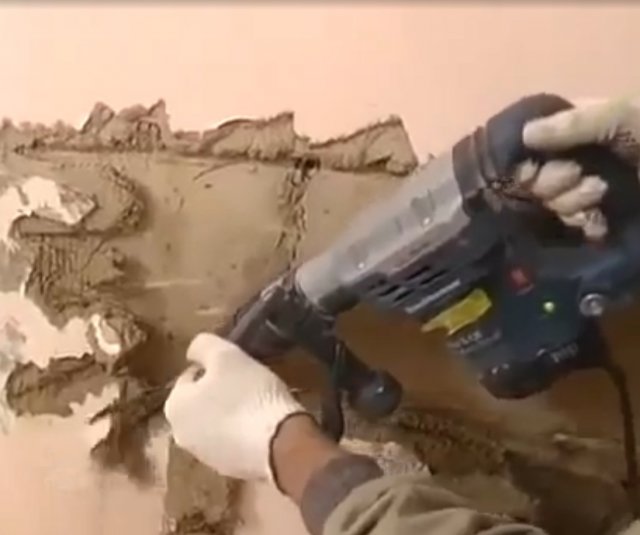
Cleaning the walls
Stages of coating waterproofing walls with NTs cement
1. Before starting waterproofing, to prevent ruptures, it is necessary to smooth out all internal corners: there should be no too sharp corners and transitions.
2. To damp deformations at the joints, all places where metal or plastic pipes and docking with wooden structures coated with elastic compounds or wrapped with sealant.
3. Mortars of such cement are applied to the walls as usual plaster in layers, each layer 15 mm thick. The total thickness of the wall coating is from 3 mm.
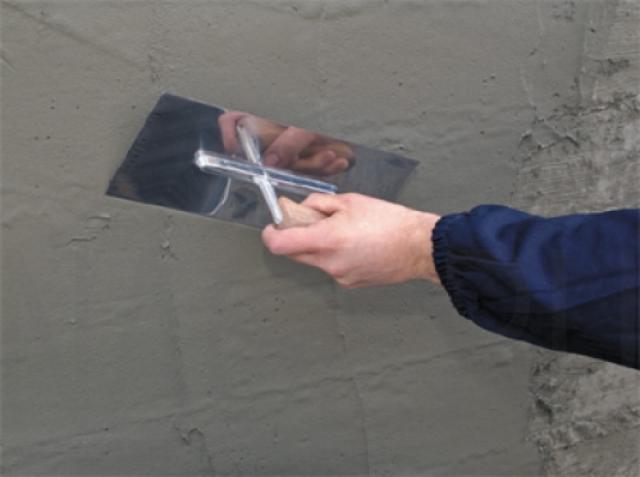
Coating waterproofing
4. In corners, places of abutments and joints it is better to reinforce walls with wire mesh.
5. The surface should dry slowly. To increase the durability of such a coating, even in a damp basement, so that the walls do not harden ahead of time, they are periodically moistened for 10 days.
Basement floor sealing
Very often, condensation in the basement forms due to temperature differences due to the rise of warm air from the living quarters. In such a situation, external hydro and thermal insulation would be an ideal solution.To do this, first a polyethylene film or any other vapor barrier material with an overlap of strips is attached to the ceiling, then the bars are nailed. Any heat-insulating material is laid between them. To protect it from moisture, a layer of waterproofing is laid on top.
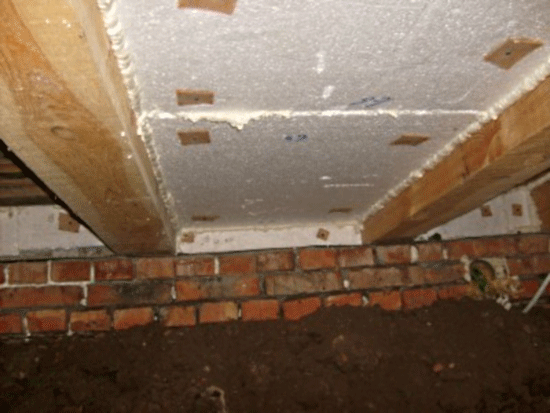
Basement floor insulation
Basement protection from water is one of the main tasks in its construction. It includes a whole range of measures to ensure the watertightness of the basement walls and floor, as well as to prevent the rise of water inside the structure through capillaries. The most reliable waterproofing can be performed only at the construction stage, all subsequent work will be only half measures that will not give a long and sustainable result. But what if you bought a ready-made house and found that there is often water in the basement? What measures to take, what materials to use. Within the framework of this article, we will tell you how to make a basement waterproofing in an operating building and what materials to use for certain works.
What can be the basement waterproofing
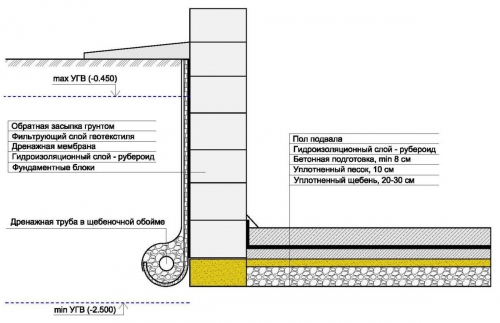
Before going directly to waterproofing materials, I would like to clarify what we will protect our basement from. In total, there are three types of waterproofing: anti-pressure, non-pressure and anti-capillary.
Anti-pressure waterproofing basement is necessary when the groundwater level is above the basement floor, and sometimes the walls too, or if there is a seasonal rise to such a level during spring floods. Such waterproofing is equipped only outside the structure of the walls and floor. Materials are used that withstand the so-called positive water pressure. This is when water presses the weight of the material to the surface of the structure, such as a wall. But waterproofing the basement of the house from the inside with these materials is useless, since there is negative water pressure acting on the separation of the material from the surface. In addition to everything, with high groundwater, it will not be superfluous to drain around the basement to drain water into a sewer or sewer.
Non-pressure waterproofing the basement is to protect against water accumulated due to precipitation or floods. Of course, if anti-pressure waterproofing has already been completed, then there is no point in non-pressure waterproofing. But if the groundwater level at the site is rather low and there is no probability of its seasonal rise, then you can only do with non-pressure waterproofing measures, for example, smear the floor and foundation walls with bitumen mastic.
Anti-capillary waterproofing is designed to prevent the rise of water through capillaries in the concrete walls of the foundation and floor. This will protect the structure of the house from destruction. If earlier, to protect the walls of the house from rising moisture, they just smeared with bitumen or covered the top of the foundation with roofing material before arranging the walls, today the use of penetrating waterproofing is gaining more and more popularity.
Basement waterproofing: materials and technologies
The modern market is saturated with various waterproofing materials. They can be conditionally divided according to the method of application and the principle of action into several categories: coating, roll, water repellent, penetrating or injection. Each of them is good in its place.
Lubricating waterproofing materials
This very broad category includes a variety of emulsions, bitumen-based mastics that can be applied both cold and hot, thick-layer bituminous coatings, cement-based compositions, polymer coating materials.

Mastics are made from special bitumen, which is refined with synthetic rubber, do not contain solvents. They can be applied to any solid, stable base: concrete, brick, plaster, stone and others, after moistening them. After the mastic dries, a seamless, highly elastic film forms on the surface. Such a coating covers all cracks, is not afraid of cold and heat, does not allow water to pass through, and is resistant to aggressive environments. Basement waterproofing means applying mastic to the outer wall of the foundation to protect it from groundwater and storm water. This material withstands only positive water pressure. Although sometimes mastics are used to fill expansion joints, so be sure to read the instructions before buying.
For example, bituminous mastics "Elastopaz" and "Elastomix", which are also called liquid rubber, are applied to the surface of the floor and walls of the basement from the inside. But remember, the material is not able to resist negative water pressure for a long time, therefore, if the external waterproofing of the basement is not performed, then over time the liquid rubber can break and leak.
High-build bituminous coatings one and two-component are used only to protect house structures from pressurized water, they are applied outside the foundation walls and before pouring the basement floor. They are used on any mineral surfaces: concrete, brick, hollow blocks, sandstone, limestone, plaster, porous concrete and others.
Cement-based compositions can be roughly divided into conventional cement-based coating waterproofing, cement-based coating waterproofing with a penetrating effect and auxiliary compositions.
Plain cement coating waterproofing also called armoring, it can be applied to any mineral surface. Some materials, after application, can create an elastic coating that will bridle newly formed cracks even up to 2 mm wide.
Cement waterproofing with penetrating effect only applicable on concrete surfaces good quality... If cracks and capillaries are larger than 0.4 - 0.5 mm, the material will not work.
Polymeric coating waterproofing materials include polyurethane-based materials and universal materials based on MS polymers.
Polyurethane based materials used for durable waterproofing, used in liquid form, are one or two-component coatings that are applied and hardened in a cold state. It makes sense to apply these materials only on the side that faces the water. In this case, you must first carefully prepare the base: it must be clean, dry, without flaws that could impair adhesion.
Universal waterproofing based on MS polymers combines the advantages of silicone and polyurethane. This material appeared on the market relatively recently, but has already gained confidence, as it provides reliable crack bridging up to 10 mm and waterproofness at the level of a thick-walled coating, and it is applied as easily as a conventional bitumen emulsion, again, on the side facing the water ...
Woven waterproofing materials
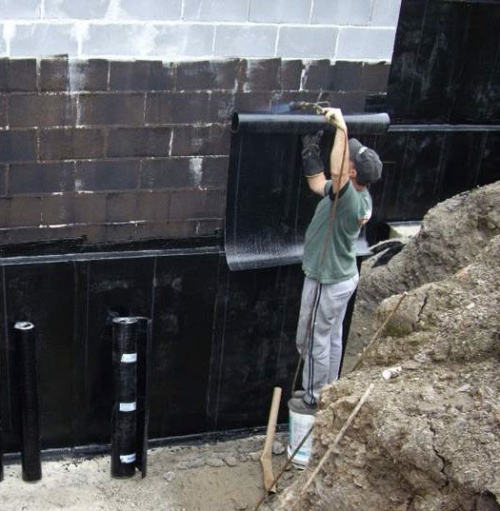
Gluing waterproofing is performed using roll materials, by gluing them to the base in several layers. For this you can use roofing felt, glass-insol, glass roofing material, hydrostekloizol, glass felt, hydroisol, hydrobutyl and others. Before installing the glued waterproofing, the surface must be carefully processed: level (irregularities up to 2 mm are allowed), dry, prime with a bitumen emulsion. The formed coating is sensitive to mechanical damage, therefore it is imperative to protect it with a pressure wall.
These materials are a relatively new way of making surfaces water-repellent. With a surface treated with a water repellent, water simply rolls off. But when new cracks appear, the material is not able to heal them, and it does not penetrate deeply into the surface structure, no more than 5 mm, therefore, over time, it is washed out and eroded. Gradually, the water-repellent properties decrease: if the material is water-based, then after 1 - 3 years, and if it is on solvents, then 5 - 10 years.
Penetrating waterproofing
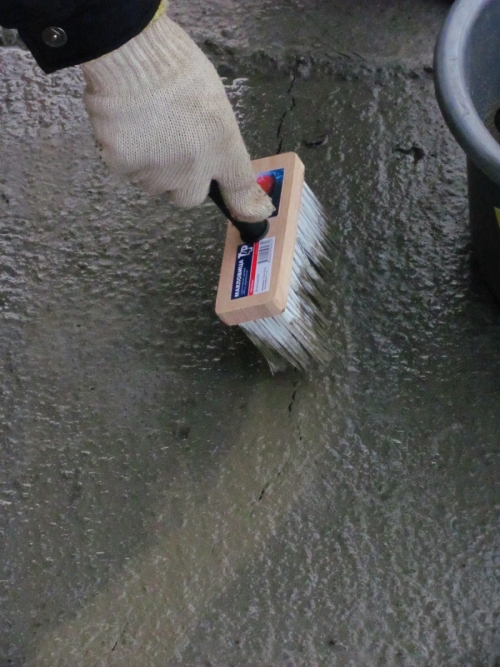
It is used for waterproofing concrete structures... The composition applied to the surface is a mixture of Portland cement, active chemical additives and finely ground quartz sand. It must be applied on a damp surface, while the active elements react with water, as a result of which crystals are formed that fill all pores, capillaries and cracks in concrete and do not allow water to pass through. The penetration depth of crystals is from 15 to 25 cm, but some brands claim that their material is capable of penetrating up to 90 cm deep.
Penetrating waterproofing is a great way to insulate a basement from the inside. But at the same time it has several drawbacks: it is used only on concrete surfaces, the concrete must be of good quality, with capillaries and cracks up to 0.4 mm deep.
Asking the question of how to properly waterproof the basement, pay attention to the fact that almost all materials offered by the market are suitable for external waterproofing: coating, gluing, water repellents, liquid rubbers and others, and penetrating waterproofing can be used for internal waterproofing. In this case, the term internal basement waterproofing means protection of the basement from ground or storm water, as well as capillary. Because if you want to protect the basement from water that may appear due to leaks in communications, i.e. inside the basement, then coating materials, mastics and emulsions can be used to waterproof the floor.

The situation when water enters the basement, and it is not possible to complete a full-fledged external waterproofing, is not uncommon. Quite often, there is simply no external waterproofing of the foundation, or it has collapsed from time to time. At the same time, it is not possible to dig out the foundation and carefully process its surface due to the fact that the houses are too close to each other or for other reasons. That is why homeowners are looking for opportunities to waterproof the basement with their own hands, without resorting to earthworks.
Important! We want to warn you right away that waterproofing outside the foundation walls will be required for high-quality protection against groundwater. Only in this way will moisture not penetrate into the walls and into the basement, pressing waterproofing material to the wall surface. If there is no external waterproofing of the foundation walls, water will penetrate into the thickness of the walls, and then into the basement.
Do-it-yourself basement waterproofing from the inside can include several types of work, for example, anti-capillary protection of concrete walls and basement floors and protection with liquid rubber.
Among all materials of penetrating action, the following can be distinguished:

- Mixtures that are applied to concrete surfaces both outside and inside structures to make them waterproof;
- Mixtures and compositions for sealing seams, cracks, joints. They are used in combination with the first mixtures;
- Fast-hardening compounds that can stop the flow in a matter of seconds;
- Additives to concrete mortar, which are used during the construction phase.
Before treating the surface inside the basement with penetrating waterproofing, it is necessary to clean the room and carefully prepare the concrete surfaces. This is some of the complexity of the use of penetrating materials, since to clean and moisten the concrete, you will have to use a special technique or do it manually. If the capillaries of the concrete are closed, the material cannot get inside.
Important! Penetrating waterproofing is applied only to wet concrete. It is better if it is freshly poured.
All cracks, cracks must be opened and cleaned, and then repaired with material for joints and seams, for example, "Penekrit".
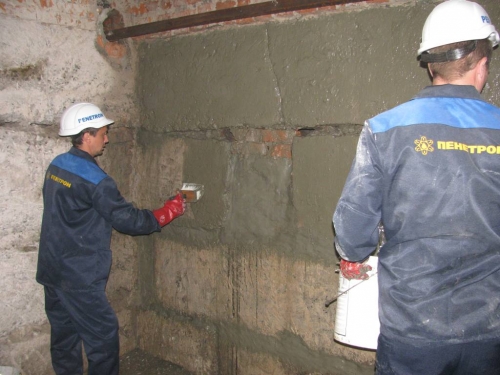
Then, according to the instructions, a solution for walls and floors is prepared, for example, "Penetron", and applied with a brush or roller with a layer of 1 - 2 mm. Then you need to let the first layer dry and absorb and repeat the operation. Reacting with water, the material forms hydrophobic crystals, which spread into the depth of the concrete structure by 10-15 cm, and sometimes more, clogging the capillaries and preventing water from penetrating not only into the basement, but also into the concrete structure.
More details about complex penetrating basement waterproofing video.
On the market, you can choose a material more suitable for certain conditions: "Gidrokhit", "Lakhta", "Kalmatron", "Xaypex", "Maxill", "Penetron".
Basement waterproofing with liquid rubber
As an additional measure to the penetrating waterproofing of concrete, the walls and floor of the basement can be treated with liquid rubber - a modern polymer or bitumen waterproofing material.
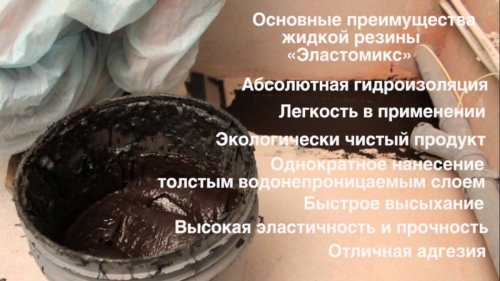
For self-application, one-component materials are suitable, for example, Elastopaz and Elastomix, which can be applied with a roller or brush without heating. Moreover, work can be carried out at any time of the year. The formulations are sold ready-to-use, just open the bucket and mix thoroughly.
To waterproof the basement with liquid rubber, the surface on which it will be applied must be cleaned of dust and debris, dried, if necessary, and leveled. In principle, careful alignment is not required, since the material itself will close all cracks and bulges, forming a membrane, but in the case of too large differences in height, material consumption will increase.
Then we apply a primer to the walls and floor, preferably the one recommended by the material manufacturer. Next, open the bucket and mix the contents using a mixer drill attachment.
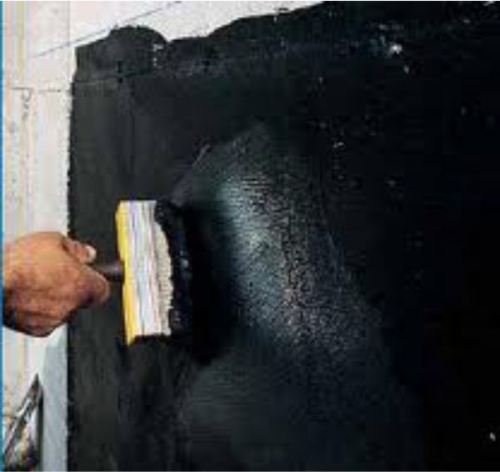
We apply the material to the surface of walls and floors with a roller, trowel or brush, paying special attention to irregularities, cracks and chips. And leave to dry. After complete solidification, the material will resemble rubber.
Waterproofing with liquid rubber from the inside of the basement does not protect the walls from penetration into their water column. Over time, the concrete will become saturated with water to the point that it begins to tear the rubber off the surface. Although the manufacturer claims that the rubber penetrates up to 15 mm deep into the concrete, in the event of serious ground or storm water pressure, this coating will last no more than 4 - 5 years.
Since such materials are not designed for negative water pressure, it is advisable to equip the pressure walls and perform the floor screed with a layer of up to 50 - 100 mm. This ensures that there are no leaks for quite a long time.
Internal waterproofing of the basement is just an additional, auxiliary measure. It is unable to provide maximum reliability. Therefore, at the first opportunity, it is still worth digging up the foundation and waterproofing it correctly. If the groundwater is rather low, it never bothers, then sometimes it is enough to carry out penetrating insulation from the inside, with polymer materials or special plasters on cement base... But remember, this will not protect the walls from water accumulation.
Basement waterproofing from the inside: video - review
To perform high-quality waterproofing of a concrete floor, the quality of the concrete that makes up the base for the floor should be determined. This is important - it is pointless to perform further work without information about the state of the base. It is also necessary to find out the level of the location of groundwater. This is especially necessary when working in the basement.
The location of communications must be taken into account. They can pass both across and along the intended for processing concrete surface... You should also choose in advance the material for finishing, which will eventually be used.
How to choose concrete
Floor waterproofing by concrete base good quality from M150 or higher should be performed using penetrating compounds. The substance must penetrate into the concrete structure as deeply as possible. A good option it is considered 40 cm. High-quality penetrating waterproofing goes inside to such a depth.
Measures to create waterproofing should be carried out in accordance with the rules of the Technological Regulations.
You can use any convenient tool to apply the waterproofing compound to the surface. The composition should be distributed over the surface in the form of an even layer - for this you can use a grout, that is, a polisher or a roller. Finishing work can be carried out no earlier than three weeks after isolation.
Sometimes the quality of the concrete is not particularly good. If the product itself is loose and with multiple cracks, the floor waterproofing will need to be carried out using the monolithic pouring method. A special hydraulic compound should be used. The waterproof performance ranges from W12 to W20.
To give the concrete product the required quality, special additives must be introduced into them. With their help, you can significantly increase the water resistance.
Features of work
When waterproofing, you should definitely take into account the thickness of the concrete floor. It must be done no less than 10-12 cm. It is imperative to carry out reinforcement and vibration. The joints of the floor and wall structures must certainly be carefully processed. Failure to do such work will subsequently entail the appearance of areas where moisture will seep.
Perfect for waterproofing the joints of hydro-laying or hydraulic cords. The places where communication inputs are provided are sealed with special sealing compounds. Both the pipes and the electrician must under no circumstances come into contact with moisture.
Penetrating floor insulation can be replaced with injection insulation. Various gels, polymers, resins are used as working materials. But such events belong to those that are carried out using special equipment. It is almost impossible to do this kind of waterproofing yourself.



